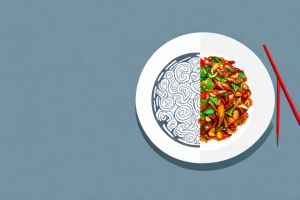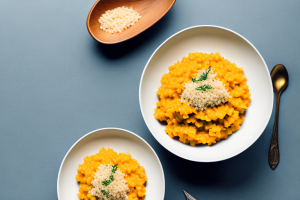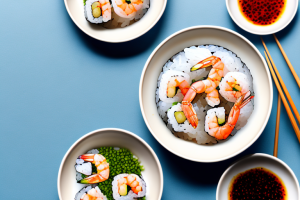How to steam brown rice with ginger and scallions
8 min read
A pot of steaming brown rice with ginger and scallions
Steaming brown rice with ginger and scallions is an easy and healthy way to add flavor and variety to your everyday meals. In this article, we’ll guide you through each step of the process, from selecting the right type of rice to adjusting the recipe to your taste preferences. We’ll also cover important tips for achieving fluffy, perfectly cooked rice every time and discuss some creative serving suggestions. So, let’s get started!
The benefits of steaming brown rice
Brown rice is a highly nutritious food that is rich in fiber, vitamins, minerals, and antioxidants. Unlike white rice, which has been stripped of its bran and germ, brown rice contains all parts of the grain, making it a much healthier choice. Steaming is an excellent way to cook brown rice, as it helps to preserve its nutrients and natural flavor while giving it a light and fluffy texture.
One of the benefits of steaming brown rice is that it helps to reduce the risk of heart disease. Brown rice is a good source of fiber, which can help to lower cholesterol levels and reduce the risk of heart disease. Steaming brown rice helps to preserve its fiber content, making it an even healthier choice.
Another benefit of steaming brown rice is that it can help to improve digestion. Brown rice is rich in fiber, which can help to promote regular bowel movements and prevent constipation. Steaming brown rice helps to soften the grains and make them easier to digest, which can be especially beneficial for people with digestive issues.
Choosing the right type of rice for steaming
When it comes to steaming brown rice, it’s essential to choose the right type of rice. Look for long-grain brown rice with a low glycemic index, which means that it won’t cause a sharp spike in blood sugar levels. Avoid short-grain or glutinous brown rice, as these varieties tend to become sticky and clumpy when cooked.
Another important factor to consider when choosing the right type of rice for steaming is the age of the rice. Freshly harvested rice tends to have a higher moisture content, which can affect the texture and flavor of the cooked rice. It’s best to choose rice that has been aged for at least six months, as this allows the moisture content to stabilize and the rice to develop a nuttier flavor.
Preparing your ingredients: ginger and scallions
Ginger and scallions are two essential ingredients in this recipe, and they play a crucial role in adding flavor and aroma to the dish. You will need a piece of fresh ginger root, peeled and sliced into thin strips, and a bunch of scallions, trimmed and cut into small pieces. Make sure that you rinse the scallions thoroughly under cold water to remove any grit or dirt.
When selecting ginger, look for a piece that is firm and has smooth skin. Avoid any pieces that are wrinkled or have soft spots. To peel the ginger, you can use a vegetable peeler or the edge of a spoon. If you find it difficult to slice the ginger into thin strips, try grating it instead.
Scallions, also known as green onions, are a great addition to many dishes. They have a mild onion flavor and add a pop of color to your dish. When cutting the scallions, make sure to use both the white and green parts. The white part has a stronger flavor, while the green part is milder and adds a fresh taste to your dish.
The importance of soaking brown rice before cooking
Soaking brown rice before cooking is an important step that helps to remove excess starch and improve its texture. We recommend soaking brown rice for at least 30 minutes, but preferably one to two hours or even overnight. This will help the rice to cook more evenly and become softer without becoming mushy or gummy. Don’t skip this step!
In addition to improving the texture of brown rice, soaking it before cooking can also help to increase its nutritional value. Soaking activates enzymes that break down phytic acid, a compound that can interfere with the absorption of important minerals like iron and zinc. By reducing phytic acid, soaking can make these minerals more available to your body.
Another benefit of soaking brown rice is that it can reduce cooking time. When rice is soaked, it absorbs water and becomes more hydrated, which means it will cook faster and more evenly. This can be especially helpful if you’re short on time or if you’re cooking for a large group of people.
How to prepare your rice cooker for steaming
If you’re using a rice cooker, make sure that you clean it thoroughly and fill it with the recommended amount of water according to its instructions. Add the soaked brown rice to the rice cooker and place the ginger and scallions on top. Close the lid and set the rice cooker to the steaming function. If you don’t have a rice cooker, don’t worry! You can also steam brown rice on the stovetop using a pot and a steaming basket.
It’s important to note that the amount of water you use in your rice cooker can affect the texture of your steamed brown rice. If you prefer your rice to be softer, add a bit more water than recommended. If you prefer your rice to be firmer, use slightly less water. It may take a few tries to find the perfect water-to-rice ratio for your taste, but once you do, you’ll have perfectly steamed brown rice every time!
Step-by-step instructions for steaming brown rice with ginger and scallions
Once the rice cooker is set, allow the rice to steam for about 30 to 40 minutes or until tender and fully cooked. Don’t open the lid during this time, as this will release the steam and affect the cooking process. Once the rice is ready, use a fork to fluff it up and mix in the ginger and scallions. Serve hot and enjoy!
Did you know that brown rice is a healthier alternative to white rice? Brown rice is a whole grain that contains more fiber, vitamins, and minerals than white rice. It also has a lower glycemic index, which means it can help regulate blood sugar levels. Adding ginger and scallions to your brown rice not only enhances the flavor, but also provides additional health benefits. Ginger has anti-inflammatory properties and can aid in digestion, while scallions are a good source of vitamin C and antioxidants. So, not only is this dish delicious, but it’s also good for you!
Tips for achieving fluffy, perfectly cooked rice every time
To ensure that your brown rice turns out perfectly every time, here are some tips to keep in mind:
- Use the right ratio of rice to water. Typically, you’ll need 1.5 to 2 cups of water for every cup of brown rice.
- Don’t add salt or any other seasonings until after the rice is fully cooked.
- Let the rice sit for a few minutes after it’s done cooking to allow any excess steam to escape and prevent it from becoming sticky or clumpy.
Another important tip to keep in mind is to rinse the rice thoroughly before cooking it. This helps to remove any excess starch and debris that may be present on the grains, resulting in fluffier and more evenly cooked rice. Additionally, consider using a heavy-bottomed pot with a tight-fitting lid to ensure that the rice cooks evenly and doesn’t stick to the bottom of the pot. By following these tips, you can achieve perfectly cooked, fluffy brown rice every time.
How to adjust the recipe to suit your taste preferences
This recipe is highly versatile and can be easily adjusted to suit your taste preferences. For example, you can add more ginger or scallions if you like a stronger flavor or add different herbs and spices to make it more aromatic. You can also mix in some vegetables like carrots, peas, or bell peppers to make it more colorful and nutritious.
If you prefer a spicier dish, you can add some chili flakes or hot sauce to the recipe. On the other hand, if you prefer a milder flavor, you can reduce the amount of ginger or garlic used. Additionally, you can experiment with different types of protein, such as tofu or shrimp, to make the dish more interesting. Don’t be afraid to get creative and make this recipe your own!
Creative ways to serve steamed brown rice with ginger and scallions
Steamed brown rice with ginger and scallions is a great side dish that goes well with many types of meats, seafood, and vegetables. You can also use it as a base for stir-fries, salads, or wraps. Here are some creative serving suggestions to try:
- Serve it with grilled chicken or fish and a side of steamed broccoli or green beans.
- Use it as a filling for vegetarian sushi rolls.
- Mix it with some sautéed mushrooms and spinach for a quick and healthy lunch.
Another great way to serve steamed brown rice with ginger and scallions is to use it as a base for a Buddha bowl. Add some roasted sweet potatoes, avocado, and a soft-boiled egg for a nutritious and filling meal.
If you’re looking for a unique twist on traditional fried rice, try making a “cauliflower rice” version with steamed brown rice, grated cauliflower, and plenty of ginger and scallions. It’s a low-carb and flavorful alternative that’s sure to impress.
Storing leftover steamed rice: best practices and tips
If you have any leftover steamed brown rice, make sure that you store it properly to prevent it from spoiling or drying out. Allow the rice to cool to room temperature and transfer it to an airtight container or a zip-top bag. Store it in the fridge for up to five days or in the freezer for up to three months. When reheating, add a little bit of water or broth to help restore its moisture and fluffiness.
Nutritional information for this delicious and healthy dish
A half-cup serving of steamed brown rice with ginger and scallions contains approximately 110 calories, 2 grams of protein, 24 grams of carbohydrates, 1 gram of fat, 2 grams of fiber, and 1 gram of sugar. It’s also a good source of essential minerals such as manganese, magnesium, and phosphorus.
Frequently asked questions about cooking brown rice with ginger and scallions
Q: Is it necessary to soak brown rice before cooking it?
A: Yes, soaking brown rice before cooking can help to improve its texture and reduce cooking time.
Q: Can I use white rice instead of brown rice?
A: Yes, you can use white rice instead of brown rice, but keep in mind that white rice has a lower nutritional value and a higher glycemic index.
Q: What if I don’t have a rice cooker?
A: You can still steam brown rice on the stovetop using a pot and a steaming basket.
Q: Can I freeze leftover steamed rice?
A: Yes, you can freeze leftover steamed rice for up to three months.
Q: Can I add other vegetables or spices to this recipe?
A: Yes, you can add other vegetables, spices, or herbs to this recipe to suit your taste preferences.
Conclusion:
Steaming brown rice with ginger and scallions is a delicious and healthy dish that you can easily make at home. By following the tips and instructions in this article, you can achieve fluffy, perfectly cooked rice every time and customize the recipe to your liking. So, try this recipe and enjoy all the health benefits and flavors that it has to offer!


